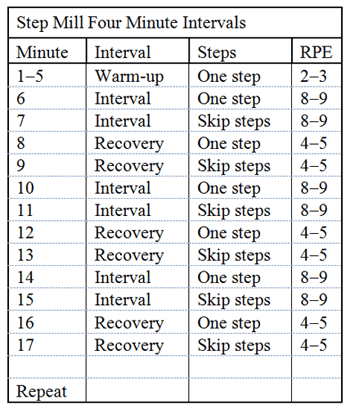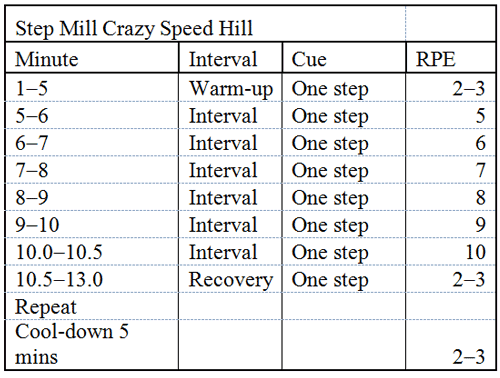
There is no question that high-intensity interval training (HIIT) is ideal for fat loss while also preserving precious muscle tissue. There have been numerous studies, articles, blogs, etc., proclaiming the greatness of HIIT. It burns more calories, increases metabolism and EPOC (excess post-exercise oxygen consumption), preserves muscles, releases growth hormone, targets stubborn fat, reduces insulin resistance, increases endurance, all in a fraction of the time of long, slow cardio.
There are countless ways to implement HIIT into your workouts, whether through cardiovascular training, weight training or a combination of the two. The basic take-home point of interval training is to achieve a high heart rate in the zone of 80 to 95 percent of your estimated max heart rate for a short duration of time (from 10 seconds to three minutes). Follow this with a brief cool-down period, bringing your heart rate back into your cardiovascular zone, usually about 50 to 75 percent of your max heart rate.
Try This Fat-Blasting Step Mill Workout
The Step Mill is one of the best ways achieve cardiovascular goals while still shaping your quads, hamstrings, and glutes. There are numerous ways to vary intensities and target different muscle groups through pace (SPM or Steps per Minute), skipping steps and the direction you face. If you have never used a Step Mill before, start slow with a few steady-state workouts. Your first time on one will prove to be intense enough without adding intervals!
Considerations
Everyone is individual and unique, so specific speeds for the following step mill workouts are not provided. An extreme athlete may be able to sprint at 12 mph to achieve 90 percent of his or her estimated heart-rate max, while a deconditioned individual may achieve 90 percent of his or her heart-rate max at 6 mph. Instead, use a rate of perceived exertion (RPE) scale of 1 to 10 to designate exercise intensity, with 1 being zero effort/resting heart rate and 10 being all out max effort, equivalent to about 95 percent of your estimated max heart rate. As a reference point, moderate cardio is usually done at an RPE of 5 to 6.
Guidelines
-Always start each program with a five- minute light warm-up.
-Do not lean your body weight on the step mill. Stand upright and rest hands on the arm rests for security only. Do not use the rails to pull yourself up, which negates the lower-body aspect of the workout.
-Modify as necessary—these are merely guidelines, so push yourself, but don’t kill yourself. Work smart!
-Get a heart-rate monitor. It makes tracking progress and getting to within your estimated max heart rate so much easier. To find your estimated max heart rate, subtract your age from 220. For example, a 30 year old has an estimated max heart rate of 190, so 90 percent of their max heart rate is 162 beats per minute.
-Not all intervals are created equal. A 30-second sprint is meant to max you out by 30 seconds, and a 60-second sprint is meant to max you out by 60 seconds. So modify your speeds. You can step much faster for 30-seconds than for 60-seconds. Know your limits!
-Never face backward on the Step Mill. It may look kind of cool, but the risk of falling is extreme and the benefits do not outweigh the consequences.
-Do not run on the Step Mill. For speed intervals, go as fast as you can without actually getting dynamic. Doing so can increase your risk of falling, possibly break the Step Mill, and prompt angry glares from other gym patrons.
-Talk to a doctor before starting any new exercise program, and avoid the Step Mill if you have knee or hip pain/conditions that have not been cleared by your physician.
The Step Mill Workouts
Step Mill Four-minute Intervals

-Start with a five-minute slow walk to warm up.
-Bring the Step Mill to a fast walk (RPE 8-9), taking one step at a time for 60 seconds.
-Stay at the same pace, but skip steps for the next 60 seconds.
-Bring the Step Mill back down to a slower pace to recover for 60 seconds (RPE 4-5), taking one step at a time for 60 seconds.
-Stay at the same pace, but skip steps for the next 60 seconds.
-One full round is four minutes; repeat three to five times.
Step Mill Glute Burn

-Start with a five-minute warm-up.
-Increase speed to slightly faster than moderate pace (RPE 6-7) and skip steps for two minutes. Focus on pushing through your heel of the stepping foot and do not use the handles to pull you up.
-Stay at the same speed and keep skipping steps. Next, add a small leg lift behind you, targeting your glute muscles. Keep your chest and torso upright to isolate that glute muscle. Stay there for one minute.
-Slow your pace to moderate (RPE 5-6). Keep doing leg lifts, but now kick slightly higher; hold the top position for a second to get that extra glute focus.
-Stay at same pace, but turn about 45 degrees to your right and cross your right leg over your left; continue climbing for 30 seconds. This better targets your inner and outer legs, plus it takes you into sagittal and transverse planes of motion. If you are advanced, you can skip steps with that right leg.
-Face your left and repeat for 30 seconds.
-Recover at same pace, facing forward and taking one step at a time (RPE 4-5).
-Each round lasts five minutes; repeat three times and finish with a five-minute cool-down.
Glute High-intensity Intervals

-Start with a five-minute warm-up.
-Increase the Step Mill to a moderate pace, but skip steps only with your right leg for 30 seconds. The pace should be an RPE of 6-7; however, when you add the skipping steps, it feels more like an 8-9! Place your left foot on the same step as your right leg, but skip a step with your right. If this is too difficult, start by taking one step at a time with your left leg, and skipping legs with your right. If you are an advanced Step Miller, try not to hold the handles at all (but keep arms at the ready just in case).
-Repeat on left leg for 30 seconds.
-Speed up to a fast pace (RPE 8-9) for one minute and skip steps.
-Recover at slow pace for one minute (RPE 3-4).
-Each round lasts three minutes; repeat five times or more!
Step Mill Crazy Speed Hill

-Start with a five-minute warm-up.
-Increase pace (RPE 5) for one minute.
-Increase pace by 5-10 SPM (or about 1 RPE) for the next five minutes, finishing at RPE 9.
-Do one final speed burst (RPE 10) for 30 seconds.
-Recover for 2.5 minutes.
-Repeat two to three times as desired.
-Cool down for five minutes.




 by
by 









 by
by